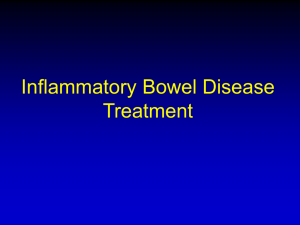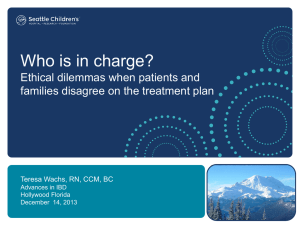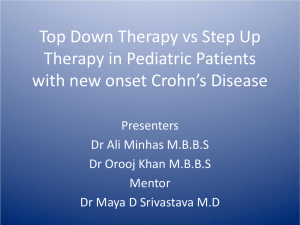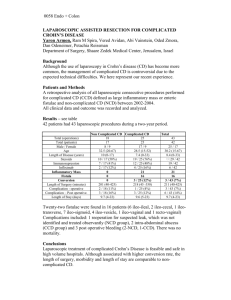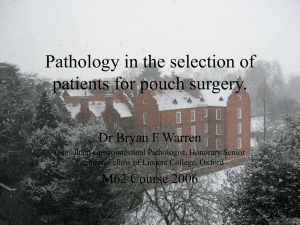crohn`s disease
advertisement
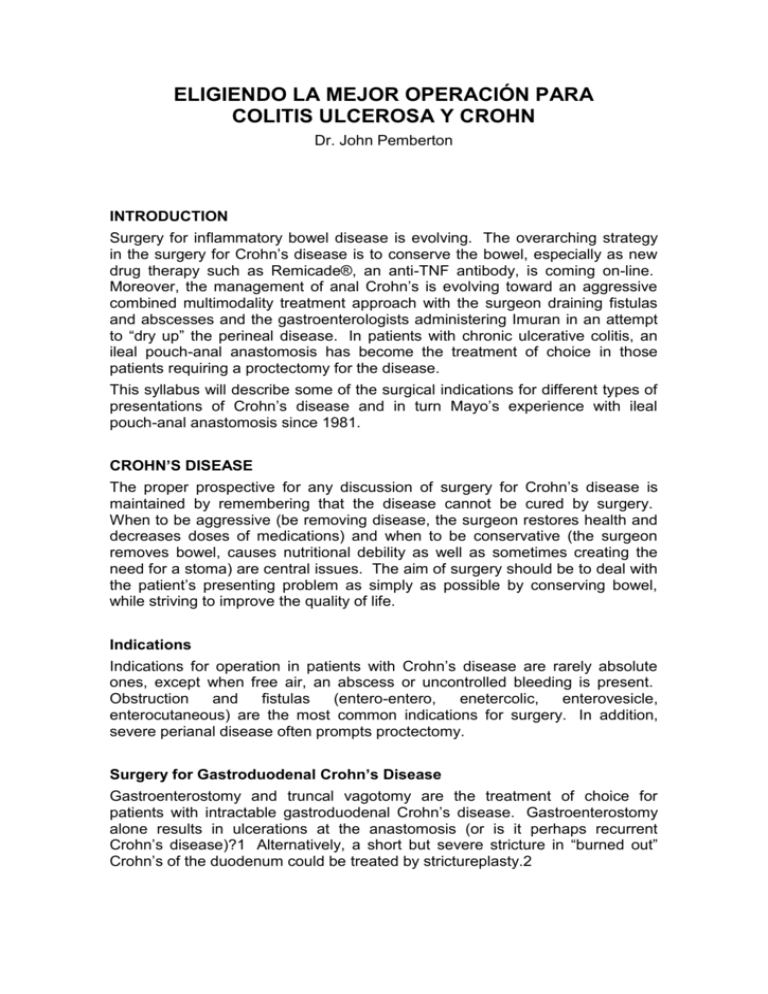
ELIGIENDO LA MEJOR OPERACIÓN PARA COLITIS ULCEROSA Y CROHN Dr. John Pemberton INTRODUCTION Surgery for inflammatory bowel disease is evolving. The overarching strategy in the surgery for Crohn’s disease is to conserve the bowel, especially as new drug therapy such as Remicade®, an anti-TNF antibody, is coming on-line. Moreover, the management of anal Crohn’s is evolving toward an aggressive combined multimodality treatment approach with the surgeon draining fistulas and abscesses and the gastroenterologists administering Imuran in an attempt to “dry up” the perineal disease. In patients with chronic ulcerative colitis, an ileal pouch-anal anastomosis has become the treatment of choice in those patients requiring a proctectomy for the disease. This syllabus will describe some of the surgical indications for different types of presentations of Crohn’s disease and in turn Mayo’s experience with ileal pouch-anal anastomosis since 1981. CROHN’S DISEASE The proper prospective for any discussion of surgery for Crohn’s disease is maintained by remembering that the disease cannot be cured by surgery. When to be aggressive (be removing disease, the surgeon restores health and decreases doses of medications) and when to be conservative (the surgeon removes bowel, causes nutritional debility as well as sometimes creating the need for a stoma) are central issues. The aim of surgery should be to deal with the patient’s presenting problem as simply as possible by conserving bowel, while striving to improve the quality of life. Indications Indications for operation in patients with Crohn’s disease are rarely absolute ones, except when free air, an abscess or uncontrolled bleeding is present. Obstruction and fistulas (entero-entero, enetercolic, enterovesicle, enterocutaneous) are the most common indications for surgery. In addition, severe perianal disease often prompts proctectomy. Surgery for Gastroduodenal Crohn’s Disease Gastroenterostomy and truncal vagotomy are the treatment of choice for patients with intractable gastroduodenal Crohn’s disease. Gastroenterostomy alone results in ulcerations at the anastomosis (or is it perhaps recurrent Crohn’s disease)?1 Alternatively, a short but severe stricture in “burned out” Crohn’s of the duodenum could be treated by strictureplasty.2 Small Bowel Crohn’s Disease There are two interesting debates in surgery for small bowel Crohn’s; the importance of microscopically free margins and resection versus strictureplasty. Pennington and colleagues3 examined the margins of resection in patients with small bowel Crohn’s disease; they found no correlation between the presence of inflammation and recurrence of disease. Wolff and colleauges4, however, found a significantly higher rate of recurrence of Crohn’s disease if the margins of resections were involved by inflammation compared to historic controls (control 45% versus involved margin 90%). In the past, it was recommended that at least 10 cm of macroscopically and microscopically free margins be achieved on either side of Crohn’s disease.5 However, other authors found no beneficial affect on recurrence by resecting increased amounts of normal bowel proximal to the uninvolved segment.6 Indeed a recent study found that it seemed entirely unnecessary to resect to microscopically free margins.2 There were some problems in this study, not the least of which was the criteria for involvement of the margin. In Pennington’s study,6 margin involvement was defined as the presence of fibrosis, edema, or increased lymphocyte or plasma cell infiltration. In our study,7 tissue destruction actually had to be present. We found that patients with microscopic evidence of residual disease had a 75% chance of developing recurrent Crohn’s disease.7 In general, the risk for recurrence of Crohn’s disease at Mayo is 15% at two years, 40% at five years, and 55% at ten years. There were also some problems with this study, the largest of which was the lack of a control group. A good rule to follow is this: in a previously unoperated patient with active small bowel Crohn’s disease, a margin of 3-5 cm should be sought proximally and distally. If the margins are involved by Crohn’s--specific inflammation (mucosal infiltration by inflammatory cells or ulceration) then an additional 3-5 cm margin should be sought. If the margin is still positive, then the anastomosis should be performed without further resection. In a patient previously operated upon, a margin of 2 cm should be sought. If positive, a further 2 cm should be resected and no more. Strictureplasty Introduced by Lee and Papaionnou8 and popularized by Alexander-Williams2, and others9 strictureplasty in selected patients with multiple areas of involvement by Crohn’s disease throughout the small bowel (skip lesions) is a valuable addition to the Crohn’s surgeon’s armamentarium. The secret of this procedure, one that flies in the face of conventional surgical wisdom, is that it is performed in segments of bowel involved by “burned out” disease. It is an elegantly simple but bold solution to the problem of conserving bowel; a simple longitudinal incision through the stricture with transverse, single layer closure (similar to the Heineke-Mikulicz pyloroplasty) is all that is done. Experienced authors have reported good to excellent results; there is surprisingly little morbidity from the procedure.2, 8, 9 The perfect patient for this approach is one who has symptoms of chronic obstruction and who has multiple skip areas of fibrotic disease. Whether to bypass diseased segments of small bowel is an argument that is passé. This operation is reserved for especially difficult situations such as ileocecal disease with a densely adherent retroperitoneal abscess. Otherwise, bypass is not useful in the management of Crohn’s disease. COLONIC CROHN’S DISEASE Segmental Resection of the Colon Segmental resection is performed in patients with ileocecal Crohn’s (ileoascending or transverse colostomy) and is the treatment of choice. In general, however, segmental resection of colonic Crohn’s disease is associated with high rates of recurrence. The best rule to follow is to resect all colon proximal to the site of disease. The scenario most appropriate for segmental resection, however, is the one where there is ileocolonic disease and isolated sigmoid involvement; in this situation, ileocolostomy and segmental resection of the sigmoid colon should be performed. Abdominal Colectomy and Ileorectostomy There is no question that for patients with colonic Crohn’s disease, but in whom the rectum is spared, colectomy and ileorectostomy is the procedure of choice.10, 11 Proctocolectomy and Ileostomy If the rectum is not spared and/or if the patient has severe anal involvement by Crohn’s disease, then proctocolectomy and ileostomy is the procedure of choice. The mortality rate is less than 2%.12 This operation has major impact, of course, on life-style; the patients are incontinent and must wear a stomal appliance at all times. However, patients are relieved of symptoms and of having to take heavy doses of steroids; in general, they recover quickly and do very well. The biggest problem after proctocolectomy for Crohn’s disease is a non-healing perineal wound which occurs in up to 1/3 of the patients.13 Anorectal Crohn’s Involvement of the anorectum by Crohn’s will be the initial manifestations of disease in about 7% of patients.14 The spectrum of involvement is vast, from a single healed secondary site to a destroyed anal canal. Fistula (simple or complex) and fissures (which are often painless but are characteristically huge and have overhanging skin edges) often smolder, controlled by metronidazole and sometimes other anti-inflammatory medications. Although proximal diversion by a sigmoid colostomy will mitigate anal disease, as soon as bowel continuity is restored, the disease recurs.15 Occasionally, a simple rectalvaginal fistula may be repaired successfully provided the rectum and anal canal are free of granularity, edema, and ulceration. Patients undergoing this procedure should be diverted. Regarding the influence of proximal disease on anorectal Crohn’s disease, we looked at a group of 86 patients who had anorectal Crohn’s disease to determine the proctectomy rate and the effect of proximal disease on anorectal function.16 The follow-up was about ten years. We found that the probability of avoiding proctectomy in patients who did not have proximal disease at the time of initial treatment of their anorectal Crohn’s disease was significantly higher than those for patients who had proximal disease (97% versus 69% of twenty years, p<0.002). Our recommendations therefore for patients with active anorectal Crohn’s disease are as follows. Certainly a conservative approach to anorectal Crohn’s disease is warranted. This means unroofing of abscesses and adequate drainage, as well as dilatation of anal stenosis. Painful fistulas and fissures should be converted to painless or asymptomatic ones either by conservative lateral internal sphincterotomy or low fistulotomy. About 85% of all patients with complicated anorectal Crohn’s disease can be relieved of their symptoms. Moreover, metronidazole treats perianal Crohn’s disease quite effectively. Hellers et al. reported that patients treated surgically for anal fistula had a much better healing rate if the proximal bowel was not involved with active disease.17 Moreover, Hellers17 suggested that anorectal Crohn’s disease should only be treated if the proximal disease has been controlled by medical or surgical management. Buchmann et al.18 and Marks et al.19 have found that the resection of the proximal bowel did not improve healing. McIlrath20 showed that proximal diversion, either by ileostomy or colostomy, was not beneficial to anorectal Crohn’s disease. Interestingly, we found that there was an early benefit in the healing of anorectal Crohn’s disease in those patients in whom all active disease was removed. However, there was no long-term benefit to the involved anorectum from resection of proximal Crohn’s disease; if active disease remained proximally or recurred, anorectal Crohn’s also persisted or recurred. Finally, we have been aggressively managing anorectal Crohn’s disease with a multi-modality approved: FK506, Imuran and prednisone, surgical draining of abscess and control of fistula seems promising and is based on several recent reports.21, 22 Recurrence Recurrence rates in patients with Crohn’s are extraordinarily high--so high, in fact, that recurrence may not be the right word--rather, recrudescence of disease may be a better term. Major factors which influence recurrence rates include: i) age, ii) site of initial disease, iii) previous disease and iv) positive margins. A randomized prospective trial was performed to determine if 5 ASA (3.0 gm/day) is effective in decreasing the risk of recurrence of Crohn’s disease. In brief, the recurrence rate among patients in the 5 ASA group was 31% while in controls, it was 41% (p=0.03).23 Comment The whole gastrointestinal tract from mouth to anus is at risk for developing the sequela of Crohn’s disease. Moreover, because the disease is not cured by surgery, recurs predictably and operations sometimes result in an ileostomy and loss of the anus, surgery should be conservative. On the other hand, symptoms are relieved and patients return to active lives. Importantly, patients with Crohn’s do not relate their quality of life whether or not an operation was required in the past, but rather to the activity of the disease.24 Summary and Future The FDA has approved the drug Remicade® for the treatment of severe Crohn’s disease. Remicade® is an anti-TNF antibody and will be available in October 1998. The efficacy of anti-TNF antibody treatment in Crohn’s disease in large populations is unknown and we all await its widespread application with anticipation. SURGERY FOR CHRONIC ULCERATIVE COLITIS EXPERIENCE WITH ILEAL POUCH ANAL ANASTOMOSIS THE MAYO From January 1, 1981, to September 14, 1998, 1,990 IPAA operations have been performed at Mayo. One thousand two hundred and eighteen patients were operated upon between January 1, 1981, and September 15, 1998 from the data base for this syllabus. The standard operation consisted of abdominal colectomy, proximal proctectomy, distal endorectal mucosal resection to the dentate line, construction of a J-ileal pouch and a pouch anal anastomosis. In addition, since 1994, double-stapled IPAA has also been performed. Most patients underwent a diverting ileostomy which was closed two to three months later. The ratio of men to women was 1:1 and the mean age of the group was 32 years. Very Early Clinical Results Ninety-six percent of patients had a protecting ileostomy established at the first operation; of these, 97% were loop ileostomies. On dismissal after ileostomy closure, 79% of patients were "completely continent," 19% were "mostly continent" (occasional daytime and nighttime soilage), and 2% were incontinent. Ninety-four percent of the patients had 10 or less stools per day and 96% had two or fewer stools at night within 10 days of ileostomy closure. Stool bulkers were given to 47% of the patients on dismissal, and agents to slow transit were prescribed for 49%. Mortality Two patients have died postoperatively. Morbidity Overall, 30% of patients had a postoperative complication. Most complications occurred in the early postoperative period and did not result in loss of the pouch or long-term disability. Pelvic infection was a serious complication occurring in the early postoperative period in <5% of patients with ulcerative colitis. CT scan was useful for demonstrating a pelvic fluid collection or phlegmon. Patients with a pelvic phlegmon usually responded to conservative treatment with broad-spectrum antibiotics and bowel rest. Patients with a pelvic abscess underwent CT-guided drainage, if technically feasible, or laparotomy and drainage. The incidence of pelvic sepsis is declining due to increased experience with the procedure, and the construction of a shorter rectal muscular cuff. The incidence of abdominal sepsis was 6%25 and was an ominous development. Ultimately, 41% of patients who underwent laparotomy for control of this sepsis required pouch excision. Moreover, normal function was achieved in only 29% of patients requiring operation. However, among septic patients who did not require reoperation, but rather aggressive non-surgical management, 92% had satisfactory pouch function over the long term. Small bowel obstruction occurred in 17% of the patients, 8% of whom required surgical intervention.26 Closure of temporary ileostomies was also associated with complications. Peritonitis occurred in 4% and postoperative obstruction in 12% of patients. Proximal and distal serosal tears during stoma mobilization, in addition to anastomotic leaks, are important causes of peritonitis. If all extraperitoneal bowel (afferent and efferent limbs and the stoma itself) are resected, however, the chance of leaving an unrecognized perforation is nearly eliminated. Nearly all patients had a web-like stricture of the ileoanal anastomosis on returning for ileostomy closure. This stricture was dilated digitally without difficulty. If the pouch retracts under anastomotic tension, heavy scarring and a long, fibrotic stricture results. This type of stricture is manifested by increased difficulty with straining at stool, a sensation of incomplete pouch evacuation, or a high stool frequency (>10-12 stools/day). Repeated anal dilatation may prevent progression of the stricture.27 Late Clinical Results The average stool frequency during the day was six stools with one stool at night. Importantly, daytime and nocturnal stool frequency and the ability to discriminate flatus from stool has remained stable over time while the need for stool bulkers and hypomotility agents has declined. This has been confirmed by others.28 Several large series have reported similar stool frequencies.29, 30, 31, 32 The lower stool frequencies six months after the operation compared to early postoperatively are likely due to increased pouch capacity with time.33, 34 Major fecal incontinence (more than twice per week) occurred in 5% of patients during the day and 12% during sleep.35 In contrast, minor episodes of nocturnal incontinence were found in 20 to 30% of patients at least one year after the operation. A pad was worn by 28% of patients for protection against seepage. Interestingly, up to 60% of fully continent women wear a pad for fear of accidental fecal soilage. Minor perianal skin irritation was reported by 63% of patients. Not surprisingly, patients over 50 years had a higher daytime stool frequency than patients under 50 years (<50 years: 6+3 stools/day vs. >50 years: 8+4 stools/day). Men and women had similar stool frequencies postoperatively but women had more episodes of fecal soilage during the day and night. Late Complications Pouchitis: The principle late complication after IPAA is non-specific reservoir inflammation or "pouchitis". The incidence of pouchitis has increased as followup has lengthened.36 At Mayo, the incidence of pouchitis among patients with chronic ulcerative colitis was 31%.36 The mean interval from operation to first occurrence was 17 months. A second episode was identified in 61% of patients. The incidence was not affected by the type of pouch constructed, presence or absence of perioperative pelvic sepsis or backwash ileitis, or the age or sex of the patient. Higher recurrence rates occurred in patients with extraintestinal manifestations of ulcerative colitis (39%) than in those without manifestations (26%).36 Furthermore, exacerbations of extraintestinal manifestations were often temporarily related to flares of pouchitis. Pouchitis is characterized by the spontaneous onset of watery, often bloody diarrhea, increased stool frequency, fecal urgency and soilage, abdominal discomfort, malaise and fever. The etiology of pouchitis is unknown but causes include disorders of pouch motility, bacterial overgrowth and by-product accumulation from intra-luminal bacterial colonization, pouch ischemia and reperfusion injury, or a de novo type of inflammatory bowel disease. To date, no distinguishing absorptive, histological, or emptying abnormality has been identified in patients with recurrent pouchitis.37 Pouchoscopy often demonstrates mucosal friability, edema or ulceration, but endoscopic findings fail to consistently correlate with clinical presentation.38 We have developed recently a pouchitis disease activity index (PDAI) which, because it uses symptoms together with endoscopic and histologic findings to arrive at an objective score, may be a better diagnostic tool than any single parameter alone.39 Traditional treatment of pouchitis has been oral antibiotics directed against anaerobic bacteria with prompt response usually seen within 24 to 48 hours of starting therapy. Those patients refractory to antibiotics may respond to sulphasalazine and/or steroid enemas. In addition, there is recent evidence that Bismuth Subsalicylate (Pepto Bismol) is efficacious in the treatment of antibiotic resistant pouchitis.40 In approximately 10% of pouchitis patients, chronic pouchitis develops requiring low-dose prophylactic oral antibiotics or enema administration. Ultimately, a small number of pouchitis patients require either pouch revision or excision. Sexual Dysfunction Impotency and retrograde ejaculation developed in 1.5% and 4% of men, respectively (11). Dyspareunia developed in 7% of women postoperatively. Interestingly, fully 49% of women noted sexual dysfunction preoperatively yet sexual activity increased dramatically after IPAA due to an improvement in general health.41 Failure At Mayo, 7% of patients ultimately required pouch excision or construction of a permanent ileostomy. Other large series have reported failure rates between 2 and 12%.29, 30, 31, 32 The most frequent causes of failure, either alone or in combination, included pelvic sepsis, high stool volumes, Crohn's disease, and uncontrollable fecal incontinence.35 Pouchitis was the sole cause in 2% of all patients who failed. Importantly, of the patients who failed, 75% failed within one year, 12% by two years, and 12% by three years. Thus, failure after IPAA is manifested within several years after the operation and is the result of a combination of early or late complications of the procedure. Quality of Life Issues of quality of life are often the deciding factor for patients choosing a particular operation for ulcerative colitis. Several studies which analyzed the outcome of surgery for ulcerative colitis have demonstrated that most patients are satisfied with the operation and lead a normal lifestyle regardless of the procedure.43, 44 The quality of life following Brooke ileostomy and IPAA for ulcerative colitis and familial adenomatous polyposis studied by us.45 Patients were highly satisfied following either operation (93% of Brooke ileostomy, 95% IPAA). However, daily activities (sexual life, sports, social, work, recreation, family relationships, travel) were more likely to be adversely affected with a Brooke ileostomy than IPAA. CONTROVERSIES Which pouch design is best? Of all the pouch designs championed in the literature ("S", "H", "W", "K" & "J"), the "J"-shaped pouch is easiest to construct and has identical functional outcomes as the more complex designs. It is thus the pouch design of choice at Mayo. TWO STAGES OR ONE? The Role of a Defunctioning Ileostomy The most feared complication of IPAA is pelvic sepsis, and therefore, a defunctioning ileostomy after pouch construction is usually performed to minimize its occurrence. Whereas pelvic sepsis complicates 6% of patients undergoing IPAA at the Mayo Clinic1, the rates reported in the literature vary between 0% and fully 25%. Moreover, disturbingly high rates of pelvic sepsis have been reported in patients undergoing a one-stage procedure (no ileostomy).46 Although the incidence of pelvic sepsis is low, when it occurs it is responsible for a significant number of the failed pouches in the Mayo series. Protagonists of defunctioning ileostomies also argue that diverting stomas allow the anal sphincter and ileal mucosa to recover before restoration of intestinal continuity, and that patients have a short-lived experience of a stoma to fully appreciate the ultimate benefit of IPAA.47 Use of loop ileostomy, however, does not appear to fully protect the patient from pelvic sepsis.48 It is nonetheless much easier to manage a patient with sepsis if an ileostomy is in place.48 Of Mayo patients who require laparotomy to control sepsis, 41% lost the pouch ultimately and only 29% ever recovered ileoanal function. However, if no reoperation was required, 92% of patients with sepsis eventually had a functioning pouch.48 This is an important observation. There is little doubt that by avoiding an ileostomy altogether, complications of closure are not an issue, and only one hospital admission is required. Low complication rates with good functional outcome have previously been reported with such an approach.49, 50 At Mayo, the clinical and functional outcomes of 37 patients who had a one-stage IPAA without a defunctioning ileostomy have previously been reported.48 The group was age- and sex-matched with 37 patients who had a defunctioning ileostomy during the same period. The incidence of complications was higher when a defunctioning ileostomy during the same period. The incidence of complications was higher when a defunctioning stoma was not used (22% versus 11%, respectively). One-stage IPAA was shown to be a reasonable option if patients were in good health, were not on chronic steroid therapy and if the IPAA could be constructed without tension or technical difficulty. A trial of 45 chronic ulcerative colitis patients randomized to defunctioning stoma (n=23) or no stoma (n=22) showed no differences in rates of complications between the groups.51 The patient group was highly selected, however, in that no patients were taking steroids. Although the authors found no increased risk of pelvic sepsis in patients without an ileostomy, the study was notable for the very high rate of ileostomy-related complications (52%). A reasonable approach to this dilemma is to use a defunctioning ileostomy in those patients receiving steroid treatment at the time of surgery and in patients who are nutritionally compromised or undergoing an urgent operation. Additionally, if there are concerns about pouch blood supply or anastomotic tension, a diverting stoma is almost mandatory. Using these criteria, 56 of 1,800 patients undergoing IPAA have had a one-stage procedure performed at the Mayo Clinic between 1980 and 1996. Double-Stapled Versus Handsewn Anastomosis Much of the debate whether to staple the anastomosis or not has evolved because functional outcomes should be improved if the anal transition zone (ATZ) is preserved. Does preserving the ATZ enhance continence after the IPAA? Stapled anastomosis in nonrandomized trials has been equated with better outcome, which in turn is attributed to less injury to the anal sphincters, with preservation of the ATZ and hence anal sensory discrimination, and with preservation of the rectoanal inhibitory reflex.52, 53, 54 However, one randomized trial by Seow-Cheon et al.54 comparing endoanal mucosectomy and handsewn anastomosis with stapled anastomosis did not show any difference in functional outcome between the two methods. We recently reported upon a randomized study of our own. Forty-one patients at the Mayo Clinic have been randomized to double-stapled (17 patients) or handsewn (15 patients) techniques.55 In the stapled group, 1.5 to 2.0 cm of ATZ was preserved, whereas a complete mucosectomy was performed in the hand-sewn group. Overall complications were the same between the groups. Stool frequency, rates of fecal incontinence during the day and night were similar between the groups. However, fewer double-stapled patients had incontinence at night. Moreover, resting and squeeze pressures were better preserved after double stapling. We concluded that both handsewn and double-stapled IPAA improved the quality of life dramatically. Double stapled IPAA had further benefits because it may better preserve the anal canal than does the handsewn anastomosis, and thus, enable older and perhaps overweight patients to be candidates for IPAA for the first time. SUMMARY The length of ileum used rather than pouch configuration per se is related to eventual functional outcome: A pouch constructed from 15 to 20 cm limbs is ideal. One-stage procedures are reasonable in those patients not malnourished or taking steroids and in whom a tension-free anastomosis is constructed. Because most of our patients do not satisfy these criteria, single-stage IPAA is rarely used at Mayo. The decision to excise the ATZ should relate to the risk of developing subsequent neoplasia. Patients who do not have a mucosectomy should have life-long surveillance. Indeed, an argument can be made that all patients should undergo surveillance after IPAA. The decision to staple the anastomosis impacts little on eventual functional outcome but does preserve the ATZ with the attendant risk of recurrent disease, polyps, and neoplasia. Ileal pouch-anal anastomosis cures chronic ulcerative colitis with acceptable morbidity and mortality. Following the operation, the great majority of patients achieve satisfactory continence with an excellent quality of life. However, continence is not perfect and fecal soilage is a troublesome problem for a small number of patients. Moreover, up to one-third of patients develop pouchitis for which an effective means of long-term prevention or treatment has yet to be developed. Finally, controversial issues such as optimal pouch design or technique of anastomosis will only be resolved when long-term follow-ups of prospective randomized trials have been completed. REFERENCES 1. Nugent FW, Richmond M, Park SK: Crohn’s disease of the duodenum. Gut, 18:115-20, 1977. 2. Alexander-Williams J: Overview of surgical management and directions of future research. In Inflammatory Bowel Disease (ed. R.N. Allan, M.R.B. Keighley, and J. Alexander-Williams, pages 496-504, Churchill Livingstone, New York, 1983. 3. Pennington L, Hamilton SR, Bayless T.M., Cameron JL: Surgical management of Crohn’s disease: Influence of disease at margin of resection. Annals of Surgery, 192, 311-8, 1980. 4. Wolff BG, Blatt RWP, Frydenberg HB, Weiland LH, Agrey MV, Ilstrup DM: The importance of disease free margins in resection of Crohn’s disease. Diseases of the Colon and Rectum, 26:239-243, 1983. 5. Bergman L, Krause U: Crohn’s disease: A long-term study of the clinical course in 186 patients. Scand J Gastroenterology, 12:937-944, 1977. 6. Pennington L, Hamilton SR, Bayless T.M., Cameron JL: Surgical management of Crohn’s disease. Ann Surg, 192:311-318, 1980. 7. Wolff BG, Beart RW Jr., Frydenberg HB, et al: The importance of disease free margin in resection for Crohn’s disease. Diseases of the Colon and Rectum, 26:239-243, 1983. 8. Lee ECG and Papaionnou N: Minimal surgery for Crohn’s obstruction in patients with extensive or minimal Crohn’s disease. Annals of the Royal College of Surgeons of England, 64:229-33, 1982. 9. Fazio VW and Galandiuk S: Strictureplasty in diffuse Crohn’s jejunoileitis. Diseases of the Colon and Rectum, 28:512-518, 1985. 10. Farnell MB, Van Heerden JA, Beart RW Jr., Weiland LH: Rectal preservation in nonspecific inflammatory disease of the colon. Annals of Surgery, 192:249-253, 1980. 11. Farnell MB and Adson MA: Current results: The Mayo Clinic experience. In Alternatives to Conventional Ileostomy (ed. R.R. Dozois), pages 100-121. Year Bood Medical Publishers, Chicago, 1985. 12. Lock MR, Fazio VW, Farmer RG, Jagelman DG, Lavery IC and Weakley, FL: Proximal recurrence and the fate of the rectum following excisional surgery for Crohn’s disease of the large bowel. Annals of Surgery, 194:754-760, 1981. 13. Wolff BG: Crohn’s Colitis. In Current Therapy in Colon and Rectal Surgery. (ed. V.W. Fazio), pages 195-198. B.C. Decker, Philadelphia, 1990. 14. Fazio VW: Crohn’s disease. In Surgical Treatment of Digestive Diseases. Chapter 39. (ed F.G. Moody), pages 655-683. Year Book Medical Publishers, Chicago, 1990b. 15. McIlrath DC: Diverting ileostomy and colostomy in the management of Crohn’s disease of the colon. Archives of Surgery, 103:308-310, 1971. 16. Wolff BG, Culp CE, Beart RW Jr., et al: Anorectal Crohn’s disease. Diseases of the Colon and Rectum, 28:709-711, 1985. 17. Hellers G, Bergstrand O, Ewerth S, et al: Occurrance and outcome after treatment of anal fistulae in Crohn’s disease. Gut, 21:525527, 1980. 18. Buchman P, Keighley MRB, Allen RN, et al: Natural history of perianal Crohn’s: Ten-year follow up: A plea for conservation. Am J Surg, 140:642-644, 1980. 19. Marks CG, Ritchir JK, Lockhart-Mummery HE: Anal fistulous Crohn’s disease. Br J Surg, 68:525-527, 1981. 20. McIlrath DC: Diverting ileostomy or colostomy in the management of Crohn’s disease of the colon. Arch Surg, 103:308-310, 1971. 21. Eagan L, Sandborn WJ, Tremaine WJ: Clinical outcome following treatment of refractory and fistulizing Crohn’s disease with intravenous cyclosporine. Am J Gastroenterology, 93:442-448, 1998. 22. Sandborn WJ: Preliminary report on the use of oral Tacrolimus (FK506) in the treatment of complicated proximal small bowel and fistulizing Crohn’s disease. Am J Gastroenterology, 92:876-879, 1997. 23. McLeod RS, Wolff BG, Steinhart AH, et al: Prophylactic mesalamine treatment decreases postoperative recurrence of Crohn’s disease. Gastroenterology, 109;2:404-413, 1995. 24. Farmer RG and Michener WM: Prognosis of Crohn’s disease with onset in childhood or adolescence. Digestive Disease and Sciences, 24:752-757, 1979. 25. Scott NA, Dozois RR, Beart RW Jr, et al: Postoperative intraabdominal and pelvic sepsis complicating ileal pouch-anal anastomosis. Int J Colorect Dis 3:149-152, 1988. 26. Francois Y, Dozois RR, Kelly KA, et al: Small intestine obstruction complicating ileal pouch-anal anastomosis. Ann Surg 209:46-50, 1989. 27. Galandiuk S, Scott NA, Dozois RR, et al: Ileal pouch-anal anastomosis. Reoperation for pouch-related complications. Ann Surg 212:446-454, 1990. 28. Fazio VW, Tjanda JJ: Pouch advancement and neoileoanal anastomosis for anastomotic stricture and anovaginal fistula complicating restorative proctocolectomy. Br J Surg 79:694-696, 1992. 29. Sagar PM, Holsworth PJ, Johnston D: Correlation between laboratory findings and clinical outcome after restorative proctocolectomy: serial studies in 20 patients after end to end pouch anal anastomosis. Br J Surg 78:67-70, 1991. 30. Becker JM, Raymond JL: Ileal pouch-anal anastomosis: a single surgeons experience with 100 consecutive cases. Ann Surg 204:375381, 1986. 31. Cohen Z, McLeod RS, Stern H, et al: The pelvic pouch and ileoanal anastomosis procedure: surgical technique and initial results. Am J Surg 150:601-607, 1985. 32. Nasmyth DG, Williams NS, Johnston D: Comparison of the function of triplicated and duplicated pelvic ileal reservoirs after mucosal proctocolectomy and ileoanal anastomosis for ulcerative colitis and adenomatous polyposis. Br J Surg 73:361-366, 1986. 33. Nicholls RJ, Pezim ME: Restorative proctocolectomy with ileal reservoir for ulcerative colitis and familial adenomatous polyposis: a comparison of three reservoir designs. Br J Surg 72:470-474, 1985. 34. Taylor BM, Beart RW Jr., Dozois RR, et al: Straight ileoanal anastomosis versus ileal pouch-anal anastomosis after colectomy and mucosal proctectomy. Arch Surg 118:696-701, 1983. 35. Pemberton JH, Kelly KA, Beart RW Jr., et al: Ileal pouch-anal anastomosis for chronic ulcerative colitis. Ann Surg 206:504-513, 1987. 36. Lohmuller JL, Pemberton JH, Dozois RR, et al: Pouchitis and extraintestinal manifestations of inflammatory bowel disease after ileal pouch-anal anastomosis. Ann Surg 211:622-629, 1990. 37. O'Connell PR, Rankin DR, Weiland LH, et al: Enteric bacteriology, absorption, morphology and emptying after ileal pouch-anal anastomosis. Br J Surg 73:909-914, 1986. 38. Di Febo G, Miglioli M, Lauri A, et al: Endoscopic assessment of acute inflammation of the ileal reservoir after restorative ileo-anal anastomosis. Gastrointest Endosc 36:6-9, 1990. 39. Sandborn WJ, Tremaine WJ, Batts KP, Pemberton JH, Phillips SF: Definition of pouchitis following ileal pouch-anal anastomosis: a pouchitis disease activity index. Gastroenterology, 104: A775, 1993. 40. Tremaine WJ, Sandborn WJ, Kenan ML: Bismuch subsalicylate tablets for chronic antibiotic resistent pouchitis. Gastroenterology, 114:A4506, PA1101, 1998. 41. Metcalf AM, Dozois RR, Kelly KA, et al: Sexual function in women after proctocolectomy. Ann Surg 204:624-627, 1986. 42. Roy PH, Sauer WG, Beahrs OH, et al: Experience with ileostomies: evaluation of long-term rehabilitation in 497 patients. Am J Surg 119:77-86, 1970. 43. McLeod RS, Fazio VW: Quality of life with the continent ileostomy. World J Surg 8:90-95, 1984. 44. Pemberton JH, Phillips SF, Ready RR, et al: Quality of life after Brooke ileostomy and ileal pouch-anal anastomosis. Ann Surg 209:620628, 1989. 45. Fleshman JW, Cohen Z, McLeod RS, et al: The ileal reservoir and ileoanal anastomosis procedure. Factors affecting technical and functional outcome. Dis Colon Rectum 31:10-16, 1988. 46. Williams NS, Johnston D: The current state of mucosal proctectomy and ileo-anal anastomosis in the surgical treatment of ulcerative colitis and adenomatous polyposis. Br J Surg 72:159-168, 1985. 47. Galandiuk S, Wolff BG, Dozois RR, Beart RW Jr: Ileal pouch-anal anastomosis without ileostomy. Dis Colon Rectum 34:870-873, 1991. 48. Sugerman HJ, Newsome HH, DeCosta G, Zfass AM: Stapled ileoanal anastomosis for ulcerative colitis and familial polyposis without a temporary diverting ileostomy. Ann Surg 213:606-619, 1991. 49. Sugerman HJ, Newsome HH: Stapled ileoanal anastomosis without a temporary ileostomy. Am J Surg 167:58-65, 1994. 50. Grobler SP, Hosie KB, Keighley MR: Randomized trial of loop ileostomy in restorative proctocolectomy. Br J Surg 79:903-906, 1992. 51. Holdsworth PJ, Johnston D: Anal sensation after restorative proctocolectomy and endorectal ileoanal anastomosis. Br J Surg 75:993-996, 1988. 52. Johnston D, Holdsworth PJ, Nasmyth DG, et al: Preservation of the entire anal canal in conservative proctocolectomy for ulcerative colitis: A pilot study comparing end-to-end ileo-anal anastomosis without mucosal resection with mucosal proctectomy and endoanastomosis. Br J Surg 74:940-944, 1987. 53. Sagar PM, Holdsworth PJ, Johnston D: Correlation between laboratory findings and clinical outcome after restorative proctocolectomy: Serial studies in 20 patients with end-to-end anastomosis. Br J Surg 78:67-70, 1991. 54. Seow-Choen A, Tsunoda A, Nicholls RJ: Prospective randomized trial comparing anal function after hand sewn ileoanal anastomosis with mucosectomy versus stapled ileoanal anastomosis with mucosectomy in restorative proctocolectomy. Br J Surg 78:430-434, 1991. 55. Reilly WT, Pemberton JH, Wolff BG, Nivatvongs S, Devine RM, Litchy WJ, McIntyre PB: Randomized prospective trial comparing ileal pouch-anal anastomosis (IPAA) performed by excising the anal mucosa to IPAA performed by preserving the anal mucosa. Annals of Surgery, 225:6; 666-677, June 1997.

